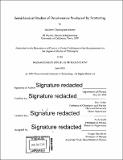Semiclassical studies of decoherence produced by scattering
Author(s)
Schram, Matthew Christopher
DownloadFull printable version (16.33Mb)
Other Contributors
Massachusetts Institute of Technology. Department of Physics.
Advisor
Eric Heller and Nuh Gedik.
Terms of use
Metadata
Show full item recordAbstract
The conventional notion of coherent atom-surface scattering originates from the existence of Bragg peaks in elastic scattering. The helium atom acts as a quantum mechanical matter wave that is coherent with itself; the well-defined phase relationship of the particle beam at the different spatial positions at surface impact implies the possibility of different non-specular outgoing beams thanks to the constructive interference of the emitted waves from each surface atom. Moreover, we still observe diffraction peaks when scattering off a lattice at finite temperature, although the peaks are here diminished by the Debye-Waller factor. However, in the case of inelastic scattering, the surface particles are displaced by the scattering atom itself and may then emit or absorb one or more phonons to the scatterer. Acoustic phonons produced by this process are gapless excitations; hence, extremely long-wavelength phonons will contribute vanishingly small shifts in energy and momentum. The difficulty in observing this is exacerbated due to the roughly 1eV resolution of high energy helium scattering experiments. So through phonon excitation the surface has "measured" the particle's presence which acts to destroy quantum coherence, though we still observe diffraction spots which imply coherent scattering. How do we reconcile these disparate viewpoints? We propose a new way of looking at the question of coherence in atom-surface scattering. Instead of considering a single beam of helium particles, we instead use semiclassical techniques to simulate an initially coherent superposition of helium particles with equal probabilities of interacting with the surface or not interacting with the surface. We then evolve the classical mechanical trajectories, and recombine the atoms after scattering to observe the resulting interference pattern. The degree to which phonons are excited in the lattice by the scattering process dictates the fringe contrast of the interference pattern of the resulting beams. We show that for a wide range of conditions, despite the massive change in the momentum perpendicular to the surface, we can still expect to have coherent (in the superposition sense) scattering.
Description
Thesis: Ph. D., Massachusetts Institute of Technology, Department of Physics, 2016. Cataloged from PDF version of thesis. Includes bibliographical references (pages 146-152).
Date issued
2016Department
Massachusetts Institute of Technology. Department of PhysicsPublisher
Massachusetts Institute of Technology
Keywords
Physics.